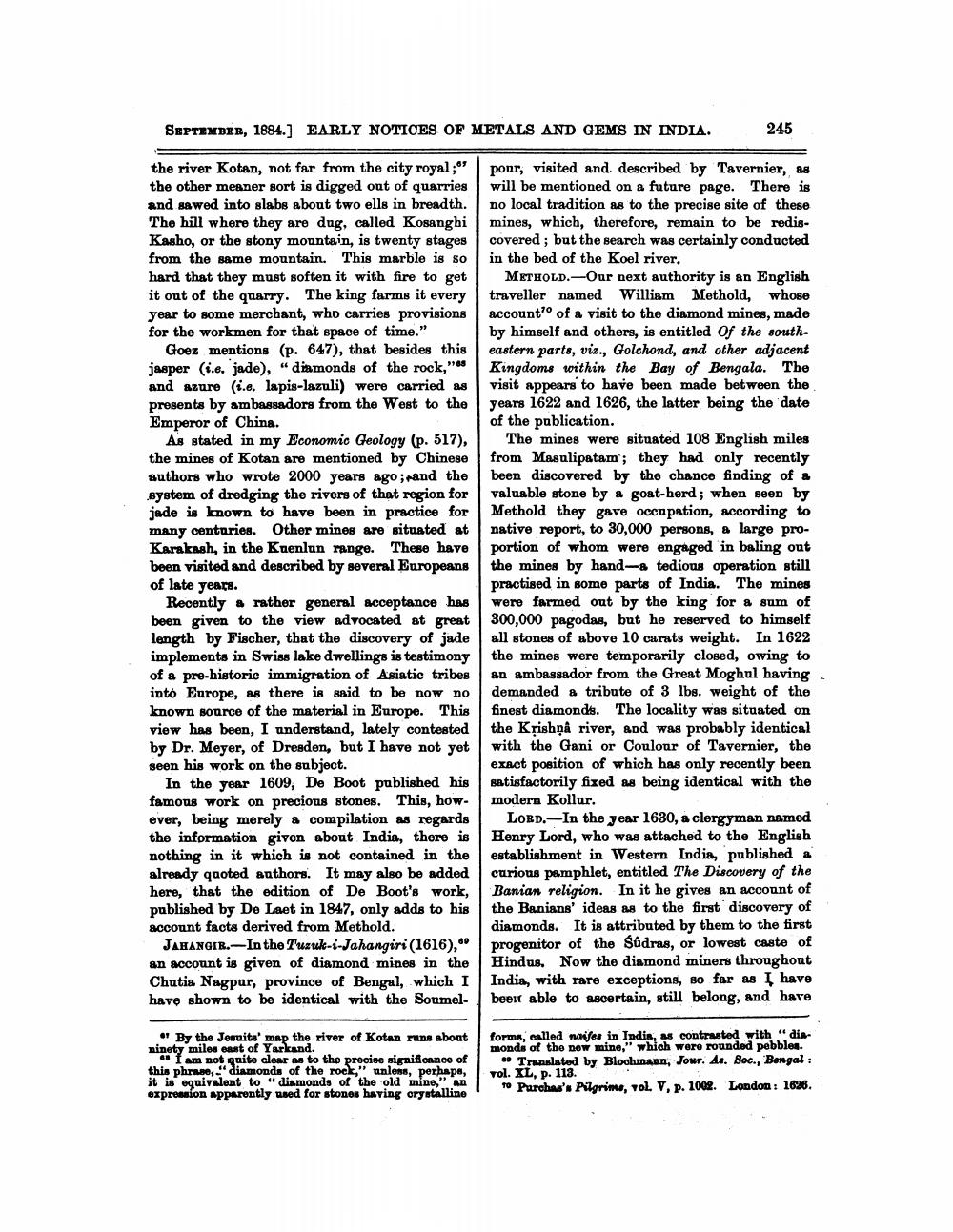________________
SEPTEMBER, 1884.] EARLY NOTICES OF METALS AND GEMS IN INDIA.
245
the river Kotan, not far from the city royal; the other meaner sort is digged out of quarries and sawed into slabs about two ells in breadth. The hill where they are dug, called Kosanghi Kasho, or the stony mountain, is twenty stages from the same mountain. This marble is so hard that they must soften it with fire to get it out of the quarry. The king farms it every year to some merchant, who carries provisions for the workmen for that space of time."
Goez mentions (p. 647), that besides this jasper (i.e. jade), "diamonds of the rock," and azure i.e. lapis-lazuli) were carried as presents by ambassadors from the West to the Emperor of China.
As stated in my Economic Geology (p. 517), the mines of Kotan are mentioned by Chinese authors who wrote 2000 years ago; and the bystem of dredging the rivers of that region for jade is known to have been in practice for many centuries. Other mines are situated at Karakash, in the Kuenlun range. These have been visited and described by several Europeans of late years.
Recently a rather general acceptance has been given to the view advocated at great length by Fischer, that the discovery of jade implements in Swiss lake dwellings is testimony of a pre-historic immigration of Asiatic tribes into Europe, as there is said to be now no known source of the material in Europe. This view has been, I understand, lately contested by Dr. Meyer, of Dresden, but I have not yet seen his work on the subject.
In the year 1609, De Boot published his famous work on precious stones. This, how- ever, being merely a compilation as regards the information given about India, there is nothing in it which is not contained in the already quoted authors. It may also be added here, that the edition of De Boot's work, published by De Laet in 1847, only adds to his account facts derived from Methold.
JAHANGIR.-In the Tuzul-s-Jahangiri (1616), an account is given of diamond mines in the Chutia Nagpar, province of Bengal, which I have shown to be identical with the Soumel
pour, visited and described by Tavernier, as will be mentioned on a future page. There is no local tradition as to the precise site of these mines, which, therefore, remain to be rediscovered; but the search was certainly conducted in the bed of the Koel river,
METHOLD.-Our next authority is an English traveller named William Methold, whose account of a visit to the diamond mines, made by himself and others, is entitled Of the southeastern parts, viz., Golchond, and other adjacent Kingdoms within the Bay of Bengala. The visit appears to have been made between the years 1622 and 1626, the latter being the date of the publication.
The mines were situated 108 English miles from Masulipatam'; they had only recently been discovered by the chance finding of & valuable stone by a goat-herd; when seen by Methold they gave occupation, according to native report, to 30,000 persons, a large proportion of whom were engaged in baling out the mines by hande tedious operation still practised in some parts of India. The mines were farmed out by the king for a sum of 300,000 pagodas, but he reserved to himself all stones of above 10 carats weight. In 1622 the mines were temporarily closed, owing to an ambassador from the Great Moghul having demanded a tribute of 3 lbs. weight of the finest diamonds. The locality was situated on the Krishộâ river, and was probably identical with the Gani or Coulour of Tavernier, the exact position of which has only recently been satisfactorily fixed as being identical with the modern Kollur.
LORD.-In the year 1630, a clergyman named Henry Lord, who was attached to the English establishment in Western India, published a curious pamphlet, entitled The Discovery of the Banian religion. In it he gives an account of the Banians' ideas as to the first discovery of diamonds. It is attributed by them to the first progenitor of the Sūdras, or lowest caste of Hindus. Now the diamond miners throughout India, with rare exceptions, so far as I have beeir able to ascertain, still belong, and have
• By the Jennita' map the river of Kotan runs about ninety miles east of Yarkand. ... I am not quite clear as to the precise significance of this phrase,.diamonds of the rock," unless, perhape, it is equivalent to " diamonds of the old mine," an expression apparently used for stones having crystalline
forms, called naifes in India, as contrasted with “ dismonds of the new mine," which were rounded pebbles.
" Translated by Bloohmaan, Jour. At. Soc., Bengal : vol. XL, p. 113.
To Purchas'. Pilgrims, vol. V, p. 2002. London: 1626.




